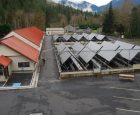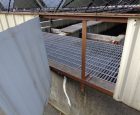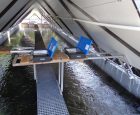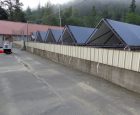
News & Views
Helpful Hatchery Hints — Belt-feeder stands
Experts at Quilcene National Fish Hatchery (NFH) in Washington State share experiences and solutions to challenges encountered in running the facility
February 1, 2018 By David Scarratt
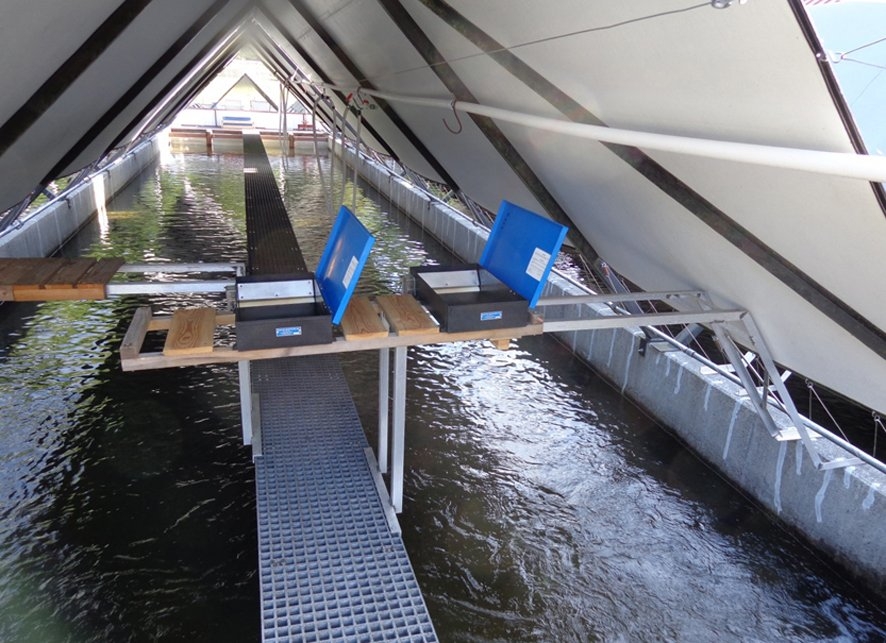 Paired feeder units located halfway down one of the 80 ft raceways
Paired feeder units located halfway down one of the 80 ft raceways Helpful Hatchery Hints
Editor’s note: Hatchery International recently received a contribution from Dan Magneson, Assistant Hatchery Manager at Quilcene National Fish Hatchery (NFH) in Washington State. In it he, and his colleague Paul Kaiser, described several issues that they have had to deal with in the day-to-day operation of the Quilcene facility, and the solutions that have been devised. There was clearly more than could be accommodated in a typical “Hatchery profile,” so we decided to describe them in a series of short articles over the next few issues. We’ll call them “Helpful Hatchery Hints”, or perhaps “Why didn’t I think of that”. It may stimulate others to share their solutions to old and new problems.
At Quilcene National Fish Hatchery in Washington state coho (Oncorhynchus kisutch) fry are transferred at swim-up directly from the incubators into 8’ x 80’ raceways. Staff use belt feeders to feed the fry starter feed. The feeders provide a constant supply of feed without staff having to feed the fish by hand. Two pairs of feeders are used, one pair at the head of the raceway and one about half way down.
The feeder stands are made from 1.5 inch (37mm) aluminum angle and consist of two rails 1 foot (30cm) apart. One side of the stand is bolted onto the edge of the grip-strut walkway and the other (outboard) side rests on top of the raceway wall. The stands are 30 inches (75cm) tall above the grip-strut walkway which facilitates cleaning and filling the feeders without having to bend over or kneel. Since the hatchery has “A” frame shade structures on its raceways the feeder stand legs on the outboard (raceway wall) side are angled to fit under the A-frame shades that are fitted over the raceways.
The paired feeders are fastened to sleds made out of 1.5 inch (37mm) square lumber so that they can be slid back over the walkway for easy cleaning and filling with feed. Crossbars under the sleds prevent them from falling off the rails when in the cleaning/filling position. Two shelves on top of each sled hold the feed buckets when filling the feeders.
The feeder stands are easily removed by loosening two bolts when hand feeding starts.
Ultimate otter barrier
The Quilcene National Fish Hatchery “had” an otter problem. Originally, the four banks of 8 x 80 raceways were surrounded by 2 x 2inch (50x 50mm) poly bird netting with a chain along the bottom to keep it on the ground.
Telltale wet marks on the raceway walls showed where otters would push under the chain weight or chew through the netting to get into the ponds during the night. Hatchery staff tried multiple strands of electric fence which worked for a while, but in time the otters became habituated to the shock and pushed through the wires regardless. And otters can easily climb over chain link fencing.
The hatchery’s solution was a physical barrier too high for an otter to jump over and too smooth to climb. This was done by fabricating a metal framework on top of the raceway walls and attaching steel roofing to making a wall at least four feet high around each bank of raceways.
Steel support brackets made from 3/16 inch (4.7mm) by 1.5 x 1.5 inch (37x37mm) steel angle iron, and 3/16 by 1.5 inch flat stock were bolted to the face and top of the raceway wall using concrete anchors and 3/8 inch (9mm) stainless steel bolts in pre-drilled holes. These support brackets were located every 10 feet (3.0m) around the perimeter of the each deck of raceways. Corner brackets were bolted onto the top and both faces of the raceway to offer support in both directions. Lengths of 3/16 thick by 1.5 x 1.5 inch angle iron bolted to the top and bottom faces of the brackets connected them together and made a framework to which the metal roofing was fastened. The upper edge of the top rail faces outward thus covering the sharp edges of the sheet metal roofing. The bottom rail was notched and bolted onto the brackets along the top of the raceway wall with the angle pointed inwards. This eliminated any foothold for otters where the metal roofing met the raceway wall.
The sheet metal panels were clamped into place on the framework, drilled and fastened with ¼ inch stainless bolts every foot, to the top and bottom rails, with the ribs oriented vertically so as to eliminate any footholds on the face of the wall. The roofing material comes in 3-foot (90cm) wide panels and was ordered precut to the required lengths. It can be cut with tin snips or a metal-cutting blade in a circular saw, but it is easier to order precut to length. It can also be ordered in many colors. We matched ours to the siding on the hatchery building. We also covered the lower four feet of all chain link fence gates that offered access to the raceways, and covered or removed any gaps or footholds. Once the metal fencing was installed the bird netting was cut to the height of the top of the metal fence. Twenty foot (6.0m) lengths of 3/8 inch (9mm) rebar was woven through the lower loops of the bird netting and attached to the top rail of the metal fence with cable ties.
The beauty of the sheet metal fence located atop a concrete surface is that the otters cannot dig or force their way underneath it. Being vertical, it doesn’t accumulate snow and get torn down, but it’s recommended to plow snow away from the fence so as not to create a ramp for otters (or mink or weasels) to exploit. Otters climb quite well and if you have things they could use as a ladder, you might want to make the otter-proof fence taller in those areas. Otters may have shorts legs but their long bodies give them a good reach. Make sure they can only make contact with slick, vertical, grip-free surfaces, and that there are no vulnerable areas they can push or dig their way through at the bottom.
Conditions at each hatchery are site-specific and you will have to decide if this exclusion fence or some adaptation of it will work at your site. The fence has worked well at Quilcene, and staff there have had had no otters raid its raceways since installing it even though they have been seen in the river and running across the hatchery grounds. Maybe this type of fence will work for you. Good luck!
The preceding article was provided by Paul Kaiser (Fish Culturist) and Dan Magneson (Assistant Hatchery Manager) at Quilcene NFH. For more information contact Dan at: dan_magneson@fws.gov.
Sidebar
Quilcene National Fish Hatchery
The Quilcene National Fish Hatchery lies in a narrow valley on the east side of Washington’s Olympic Peninsula at the confluence of the Big Quilcene River and Penny Creek. It covers slightly over 47 acres, and the main facilities include 39 raceways, each 8-feet (2.6m) wide and 80-feet (26.4m) long. Water is drawn from three intake structures (two on the Big Quilcene River and one on Penny Creek). There is a pre-settling pond, a pollution abatement pond, a hatchery building containing the office, conference room, break room, and tank room, an isolation/quarantine building, and a shop building all located on the west bank of the Big Quilcene River.
The hatchery is operated by the Fish and Wildlife Service of the US Department of the Interior and has been in continuous operation since 1911. It raises coho salmon for on-station release, and provides eggs and fingerlings for local tribal programs.
Print this page
